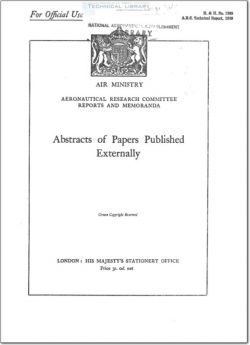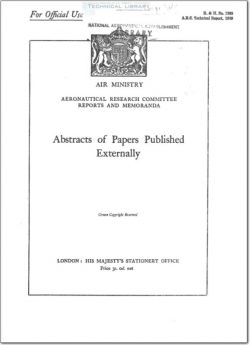ARC-RM-1868

- Version
- 63 Downloads
- 1.86 MB File Size
- 1 File Count
- June 16, 2016 Create Date
- June 16, 2016 Last Updated
Abstracts of Papers Published Externally

e study of the discharge of air from a series of ports in a duct is of practical
importance in the design of ventilating systems and in refrigeration and other
work. In this paper the question is treated theoretically. Consideration is first
given to the idealised flow of an incompressible frictionless fluid through a system
of N equal ports in a uniform duct. Two cases are considered, namely, where
there is no guiding, and where there is some guiding of the exit streams. It is
shown that in any such system neither the discharge quantities nor the angles of
discharge are uniform, but that they show a gradation along the trunkway. The
gradation is, however, independent of the total quantity or head. General formulae
are given for quantities, velocities, pressures and discharge angles.
Allowance is then made for friction, and it is shown that while this tends to
make the discharge quantities slightly more uniform, its effect in most practical
instances is negligible. In most ventilating systems it is desirable to make the
discharge quantities from the various ports as nearly equal as possible. It is shown
that it is theoretically possible to achieve equality of discharge in a uniform trunk-
way by grading the sizes of the ports. An alternative is to taper the cross section
of the trunkway while keeping the ports of equal size. Design formulae are again
given. The problem of the discharge from a long narrow parallel slot in a trunkway
is also considered and theoretical formulae are given for the velocity and discharge
angle at any point. The form of a tapering slot which will give constant discharge
per unit length is also deduced.
Scope of Work—The paper describes experiments made to determine the effects
of disturbances of known character on the laminar flow of water in a long pipe of
annular cross-section. The disturbances considered were those due to axial oscil—
lations of the inner wall of the pipe, to oscillations of the inner wall about its axis,
and to both weak and intense entry eddies. Experiments on the breakdown due
to a uniform rotation of the inner wall (outer wall fixed) were also made. The
work included observation of the breakdown of flow near a plane surface oscillating
in a stationary fluid, and the derivation of theoretical relations for the flow of a
viscous fluid through an annular pipe, under the influence of a pressure gradient
parallel to the axis, with the inner wall oscillating axially and the outer wall fixed.
| File | Action |
|---|---|
| ARC-RM-1868 Abstracts of Papers Published Externally.pdf | Download |
Comment On This Post